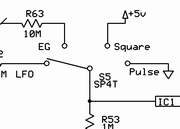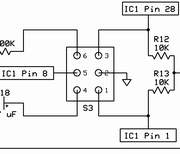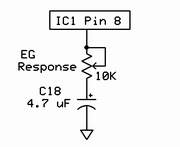The SN-Voice Project Modifications and Additions
Hop Up Your SN-Voice!
I still find it amazing how Thomas packed so much into the SN-Voice with such a tiny parts count, even taking into account the synth-in-a-chip capabilities of the SN76477. He did this all inside of a week, and right at the time we were wrapping things up, I had to leave town for a few days.
While out of town, to kill time mostly, I read up on the SN76477 and thought of some things to try out when I got home. Of course, this was all behind the curve, the SN-Voice was in the can, so to speak, and Thomas had already torn down his breadboard and turned his focus onto the next project.
My SN-Voice was still on the breadboard, and I started tinkering around. I found a few things that I thought might be some neat enhancements, but the time to include them in the final design (and run them past Thomas' scrutiny) was past.
My ethic for any modifications to the SN-Voice is this: First do no harm. I don't want to upset the balance of the circuit or adversely change its nature in any way. Secondly, the design is so eloquent, I don't want to clump it up with my usual top-heavy methods.
So, for anything that's added to the circuit that requires maybe a switch or a resistor, I'll call a modification. Any more-or-less stand-alone supporting circuit that may come along (a nifty accessory like a little mini-sequencer or comparator or anything like that) I'll refer to as an addition. I've thought of some of those, but have yet to try anything.
Fixed Narrow Pulse Selection for the PWM Switch
The PWM Switch of the original design has three positions:
- LFO Controlled PWM
- EG Controlled PWM
- 50% Duty Cycle Square Wave
This mod adds a fourth selection, a narrow pulse wave of around 20% duty cycle. IMO, it provides a great contrast from the 50% duty cycle square - it has that more funky, reedy, clav-like timbre.
This is actually quite a simple mod, probably the simplest of them all. If you are going to use a rotary switch, you'll probably have a rotary switch that allows you to configure how many positions it has. Instead of configuring it for three positions, configure it for four. This fourth position is connected to ground. This narrows out the square wave into a pulse wave and, well, that's it. A lot of bang for an extra switch position.
If you're not using a rotary switch, adding another switch is possible - this one would select between +5V and ground and have the pole of the switch tied to the third position on the PWM switch. When the PWM switch was in that position, you could choose between square and pulse wave - it wouldn't affect the LFO or EG controlled PWM when the PWM switch was switched to those positions.
I thought about using a pot for continuous variation. I actually experimented with it, but Thomas had long ago pointed out that the SN-Voice PW is of narrow of a range that a pot is overkill. He was right. However, on each extreme of the pot setting, the difference was striking enough to me to warrant that extra waveform selection.
Gated Mode Modification to Envelope Lock Switch
Another area of attack (pun intended) during my adventures on the breadboard was the response of the Envelope Generator itself. If you read the opening page of this section of my site, you'll recall I mentioned that the SN76477 EG wasn't the snappiest EG out there. It is not. This, I think, is one of those limitations of standard applications - I've noticed even on my Blacet DSC2000, the envelope takes a slightly noticeable bit of time to rise to the occasion with attack set at its fastest setting, and the decay takes just a wee bit of noticeable time to fall back to 0. This is true of the SN-Voice as well.
I found that one way around it was to create a 'Gated' mode for the SN-Voice. My old Korg Poly61 had such a mode - instead of using the envelope generator ADSR settings, pressing a key gated the VCA on and releasing it gated the VCA off - regardless of envelope generator settings. That's what this mode does - press the key, it's on, release the key, it's off, regardless of what attack or sustain are set for. This provides a much quicker response - it's quite perky and is especially great for auto-gating the SN-Voice with an LFO. What makes it really useful is using a variable pulse width LFO - you can vary the Pulse/Noise on and off time with the pulse width of the LFO (I use Ray Wilson's Cool New LFO to do just that - works great). A PWM VCO will get you the same thing when plugged into the gate input of the SN-Voice in this mode. In fact, things move so fast, you can do some nice square wave amplitide modulation. Is anyone else here thinking of an addition, a little side circuit to plant in there with the SN-Voice? Something like, oh, a spare LFO or a comparator to create square waves out of the internal SN-Voice LFO? =0)
Anyway - the mod. Again, very simple. Requires one resistor and a SPDT switch. Better yet, you can do away with the extra switch and change the S3 Envelope Lock switch from a SPDT switch to a C&K 7211 DPDT On-On-On switch (the Switch Of The Gods, IMHO). In that case, no extra front panel space is taken, and you have, IMO, a valuable extra function in the process.
The modification works by bypassing the EG capacitor and connecting pin 8 of the SN76477 to ground through a 100K resistor.
Envelope Generator Response Control Modification
Now, when I mentioned that the EG of the SN76477 was no ball of fire, I didn't say I didn't like it - I do. For one thing, the response of the unmolested SN-Voice EG dovetails perfectly with the EG controlled PWM. Another thing, corny as this may seem, is that in its natural state, it's got *that* SN76477 sound. Hey, it was good enough to emulate dying alien voices and terminal velocity spacecraft back in the early '80s. And, it sounds pretty dang good in Thomas' SN-Voice demo. But, there will be times when you want an extra bit of punch in the EG. That's where this mod steps in.
The Envelope Generator Response modification adds a pot that controls the general response time of the EG. Full CCW, the attacks and decays can be dialed up for much sharper responses - nearly as sharp as the gated mode in the previous modification. Yet, as you rotate the control clockwise, you get closer and closer to the original 'stock' SN76477 EG, until, finally, at full CW position, you're back in the realm of the SN76477 we all know and love.
The control makes a great tweak knob for autogating, too BTW. You can set it for a fairly responsive autogate in the slower 'natural' response region of the control, and as you rotate CCW, the attacks and decays become more defined and crisp.
The modification works by placing a variable series resistance between the pin 8 of the SN76477 and the EG capacitor, C18. The variable resistor in this case is a 10K linear pot, which is the EG Response Control. It's possible to have this mod in place with the above Gate Mode modification - in fact, I've had both mods on the breadboard for some time, and I find myself using both of them a lot.



